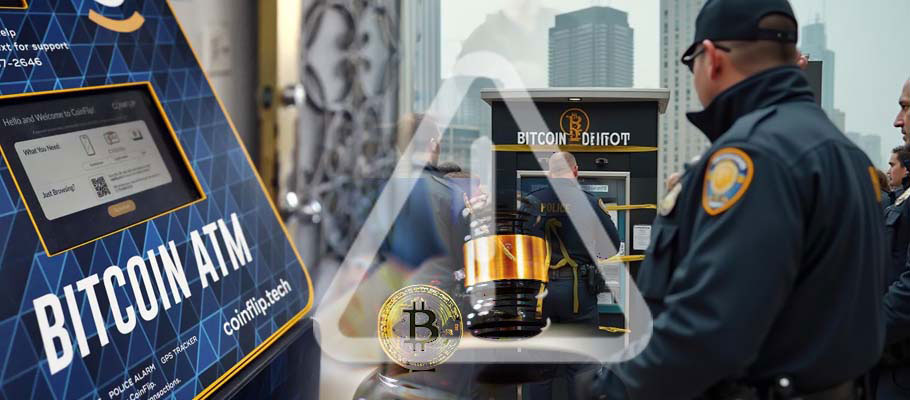
Published: July 2nd, 2025
One of America's biggest Bitcoin ATM firms says police officers breaking into cryptocurrency kiosks in order to recoup stolen money are overstepping their authority, possibly even violating US banking law.
Chris Ryan, Chief Legal Officer at Bitcoin Depot, told Bloomberg that law enforcement agencies employing brute force to open Bitcoin ATMs and seize the cash inside are bordering on legal overreach. Using industrial tools to crack them open might even be breaking federal finance law.
‘We've had a spate of rogue Sheriff's departments thinking that they're helping consumers who've been victims of fraud,’ Ryan said. ‘But in reality they're creating a second victim, which is our company.’ Bitcoin Depot, he says, is left to deal with property damage and the loss of funds collected in legitimate BTC ATM transactions.
Last week sheriffs in Texas used power tools to crack open a Bitcoin ATM and empty it of $32,000, after a family said they had been scammed out of $25,000.
An image shared on X by the county sheriff's office showed sparks flying as a police officer applied a heavy-duty circular saw to cut through a Bitcoin Depot cash machine. Images of evidence collected during the seizure showed multiple stacks of hundred dollar bills.
‘When fraudsters and other low-lifes try to take advantage of the citizens of this county, our department is committed to working fast and bringing every tool at our disposal to the task. We will protect our citizens and their property.’
Bitcoin ATMs allow people to convert cash into BTC. An FBI survey of US over-60s found that more than USD 100 million had been reported in crypto ATM-related losses last year. Scammers sometimes impersonate tech support workers or government inspectors to gain passwords or access to the ATM vaults.
Back in 2020, figures from CoinATMRadar showed a 70 per cent increase in new active automated teller machines over the previous 12 months. The first three months of 2020 alone saw more than 1,200 new Bitcoin ATMs go into active service.
It previously took four years for the industry to register its first 2,000 live installations. At the beginning of 2017 only 985 Bitcoin ATMs were in operation globally.
In 2025 the US dominates the industry with more than 30,000 installations and more than 70 per cent of global market share.
Rising Bitcoin (BTC) prices before its sudden crash in March 2021 were credited with bringing interest back to the crypto ATM space, as more people looked for accessible options for investing in digital assets.
Statistics from Google Trends showed that searches for ‘cryptocurrency cash machines’ and related terms have more than doubled since last year.
Searches spiked in June 2019 when BTC's price touched $13,000, then again in early January 2020 when the pre-COVID-19 bull market began.
Bitcoin ATM network operators have been in a pitched battle for market share. Bitcoin Depot briefly took the lead in early February 2022 when it topped 500 ATMs, but the following week competitor Coinsource said it had jumped ahead to top 600. Current numbers from Coin ATM Radar show CoinCloud in the lead with more than 650 machines live on its network.
The survival rate of ATM networks is closely related to size. While hundreds of network operators have popped up in recent years, firms that peaked at between 1 and 10 machines only lasted eighteen months on average, and since 2015 more than 300 have already closed down. Firms that hit the 100 or more machines mark have proven to be more resilient.
On the manufacturing side, there are more than 40 known crypto ATM suppliers, but the majority of production comes from a handful of majors. Genesis Coin claims the largest market share with 33.8 percent of installed machines, followed by General Bytes at 30.7 per cent.
Bitcoin ATM transactions represented just a small fraction of BTC's $4 billion 2019 payments volume. Today it's normal for traditional bricks & mortar businesses to accept cryptocurrency for payment.
Crypto ATMs have occupied an obscure corner of consumer finance for years. The world's first Bitcoin cash machine was installed at a coffee shop in downtown Vancouver, BC. in 2013. A year later, there were only four bitcoin ATMs in the US. It took roughly five years for the total number of worldwide Bitcoin ATM installations to hit 2,000.
So where is today's surge in ATM demand coming from? With high fees taking a chunk out of the funds received or paid, analysts have suggested other reasons why ATMs are becoming more popular.
Anonymity may be one advantage. Users can obtain cryptocurrency by merely walking up to a machine rather than registering with an online service, though that advantage depends on the country and jurisdiction. In the US, for example, Bitcoin ATMs are classified as Money Services Businesses, meaning they are subject to anti-money laundering (AML) and know-your-customer (KYC) laws.
The real early adopter market is more likely to be found in the millions of ‘unbanked’ consumers who don't have a regular savings or checking account. For them, a bitcoin ATM is a way to take part in the digital economy, converting cash into digital holdings and using it to make e-commerce purchases, or pay bills online using their smartphones.
Crypto ATMs are also being used by some immigrants and expats who don't have bank accounts but want to send money back to family and friends in their home countries. Wire services like Western Union and MoneyGram remain popular, but with legacy processes and systems leftover from the pre-internet days, they are seen as slow and cumbersome.
The coronavirus pandemic may also be pushing more consumers to consider cryptocurrencies as a safe haven asset, and some are increasing their holdings to protect savings against coming inflation.